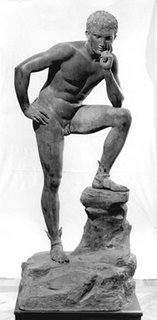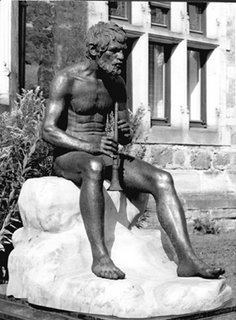Adolf von Hildebrand (1847-1921)

The name of Adolph von Hildebrand came up in my last post (in contrast to Bourdelle)-- and now with a little more internet research -- I realize that I met this name before: His book, "The Problem of Form in Painting and Sculpture", was something of a sacred text to one of my favorite American sculptors of the early 20th Century, Elie Nadelman -- and I tried, without success, about 4 years ago, to find an English translation.
He looks like a bright, serious, handsome young man, doesn't he ? (above portrait done by a young friend of his in Rome)

The notion of "architectonic unity" is in the critical language that I received from my father's teacher -- so I guess when it is run up the flag pole, I click my heels and salute it -- although I think it's power lay in the early Renaissance pieces that were associated with it -- rather than in some kind of philosophical principle. (i.e. - I think it could just as easily be applied to things that are tedious/boring as to things that are thrilling and beautiful)

Now there's a German website for Hildebrand -- and for the first time, I've gotten to see pictures of his work.

And to my happy surprise, there's also a Japanese essay online -- which attempts to explain Hildebrand's famous book.
Regrettfully -- I know as little after reading that essay as I knew before. What are the "two ways of seeing"? I just can't figure it out. But I was thrilled to note that the author claims that Hildebrand's ideas were important to Japanese art historians -- and, yes, I do see a connection between H.'s classicism and the famous statues of Japanese Buddhism.

Apparently, sculptural relief best embodied the "best way to see" -- and I like the sweet, cool rationality of the following relief:

.. as well as the hilarious goofiness of the next one:

The German website claims that H. was quite famous in his day -- the peer of Rodin -- so how the mighty have fallen -- mostly, I suppose, because German classicism was adopted as the mascot of National Socialism -- and they both went down the drain together.
(for a nice contrast -- compare the above pieces to something by one of his contemporaries, Hermann Hahn, represented by a statue in Chicago - as photographed by Tom Merkle

How to describe that difference ? Maybe "architectonic unity" will do -- if we're thinking about the architecture of the spirit -- where the one serves as a chapel -- and the other as a shopping court.


2 Comments:
Actually, the Hahn looks more soz-nazionalistisch to me.
Me too. Hahn was 62 when the Nazis came to power -- but I don't know whether he joined his many colleagues who worked for them.
Post a Comment
<< Home